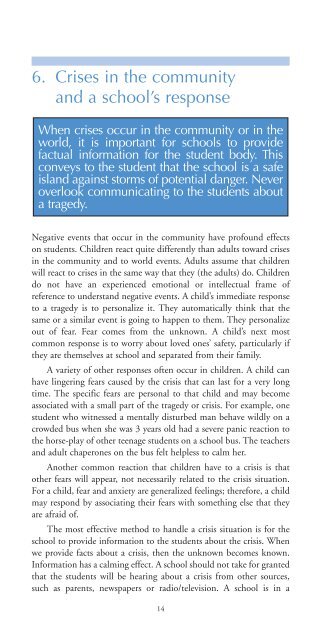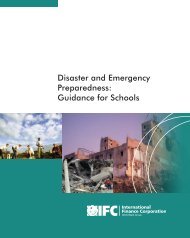Creating a safe and welcoming school - INEE Toolkit
Creating a safe and welcoming school - INEE Toolkit
Creating a safe and welcoming school - INEE Toolkit
- No tags were found...
Create successful ePaper yourself
Turn your PDF publications into a flip-book with our unique Google optimized e-Paper software.
6. Crises in the community<strong>and</strong> a <strong>school</strong>’s responseWhen crises occur in the community or in theworld, it is important for <strong>school</strong>s to providefactual information for the student body. Thisconveys to the student that the <strong>school</strong> is a <strong>safe</strong>isl<strong>and</strong> against storms of potential danger. Neveroverlook communicating to the students abouta tragedy.Negative events that occur in the community have profound effectson students. Children react quite differently than adults toward crisesin the community <strong>and</strong> to world events. Adults assume that childrenwill react to crises in the same way that they (the adults) do. Childrendo not have an experienced emotional or intellectual frame ofreference to underst<strong>and</strong> negative events. A child’s immediate responseto a tragedy is to personalize it. They automatically think that thesame or a similar event is going to happen to them. They personalizeout of fear. Fear comes from the unknown. A child’s next mostcommon response is to worry about loved ones’ <strong>safe</strong>ty, particularly ifthey are themselves at <strong>school</strong> <strong>and</strong> separated from their family.A variety of other responses often occur in children. A child canhave lingering fears caused by the crisis that can last for a very longtime. The specific fears are personal to that child <strong>and</strong> may becomeassociated with a small part of the tragedy or crisis. For example, onestudent who witnessed a mentally disturbed man behave wildly on acrowded bus when she was 3 years old had a severe panic reaction tothe horse-play of other teenage students on a <strong>school</strong> bus. The teachers<strong>and</strong> adult chaperones on the bus felt helpless to calm her.Another common reaction that children have to a crisis is thatother fears will appear, not necessarily related to the crisis situation.For a child, fear <strong>and</strong> anxiety are generalized feelings; therefore, a childmay respond by associating their fears with something else that theyare afraid of.The most effective method to h<strong>and</strong>le a crisis situation is for the<strong>school</strong> to provide information to the students about the crisis. Whenwe provide facts about a crisis, then the unknown becomes known.Information has a calming effect. A <strong>school</strong> should not take for grantedthat the students will be hearing about a crisis from other sources,such as parents, newspapers or radio/television. A <strong>school</strong> is in a14
















